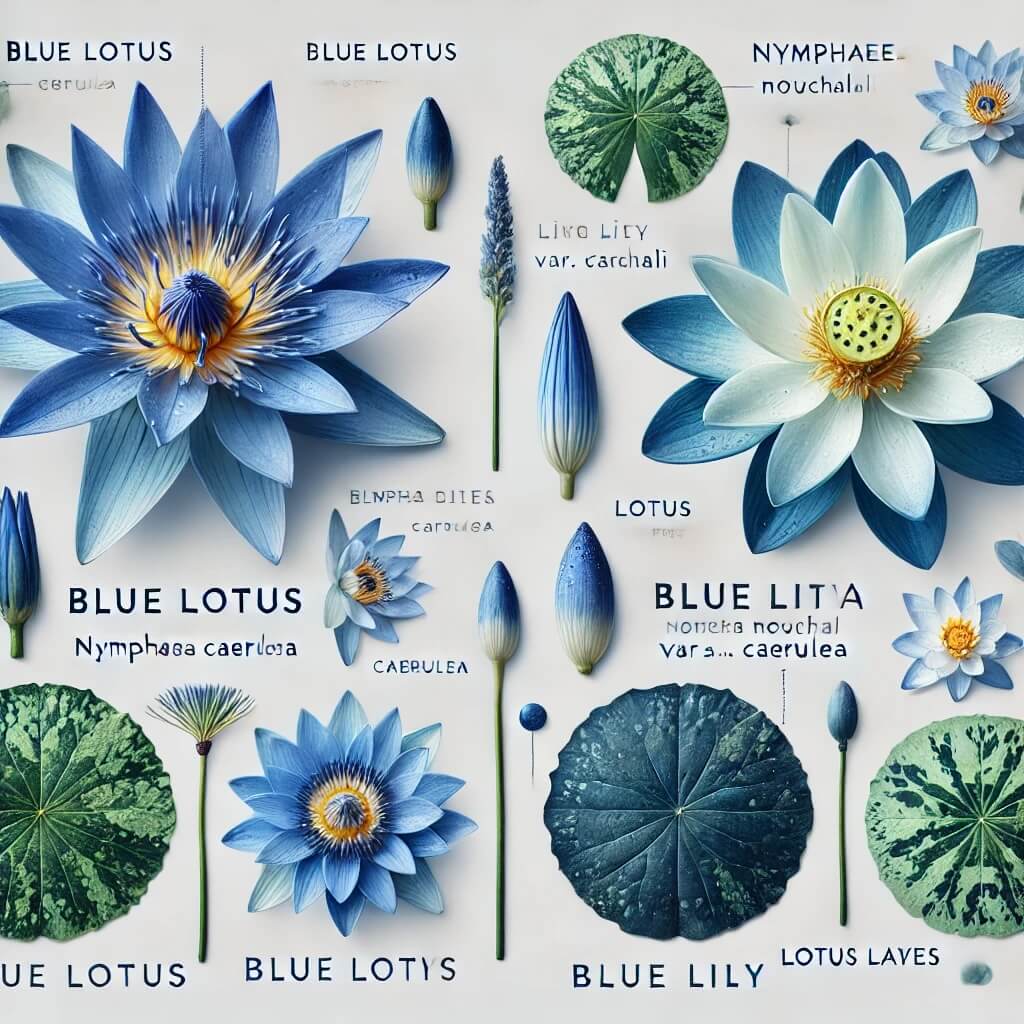In the world of aquatic plants, the Blue Lotus (Nymphaea caerulea) and the Blue Lily (Nymphaea nouchali var. caerulea) often cause confusion due to their similar appearance and overlapping common names. However, these two plants, along with water lilies and lotuses, have distinct characteristics that set them apart. This article will explore the differences between Blue Lotus and Blue Lily, the distinction between lily pads and lotus leaves, and clarify the often-confused difference between lotus and water lilies.
Blue Lotus vs. Blue Lily: Not Just a Name Game
The terms “Blue Lotus” and “Blue Lily” are often used interchangeably, but they refer to different species within the Nymphaea genus. Understanding the differences between these two plants is crucial for those interested in their unique properties, whether for horticultural, spiritual, or medicinal purposes.
Botanical Differences
• Blue Lotus (Nymphaea caerulea): This plant, also known as the Egyptian Lotus, is revered for its historical and spiritual significance, particularly in ancient Egyptian culture. It is a water lily but is often called a lotus due to its symbolic representation of life, death, and rebirth. The Blue Lotus has light blue petals with a yellow center and is known for its psychoactive properties, which induce a mild state of euphoria and relaxation.
• Blue Lily (Nymphaea nouchali var. caerulea): While also a member of the Nymphaea genus, the Blue Lily is distinct from the Blue Lotus. It is native to South Asia and Africa and is often found in shallow waters. Its petals are usually darker blue or purple, and it lacks the same psychoactive effects found in Blue Lotus. The Blue Lily is primarily used for ornamental purposes in ponds and water gardens.
Uses and Benefits
• Blue Lotus: Traditionally used in teas, tinctures, and aromatherapy, Blue Lotus is sought after for its calming and mildly sedative effects. It has historical significance as a symbol of spirituality and is still used in modern wellness practices to promote relaxation and stress relief.
• Blue Lily: While it doesn’t share the psychoactive properties of Blue Lotus, the Blue Lily is valued for its beauty and its use in traditional medicine in some cultures. It is primarily used to enhance the aesthetic appeal of water gardens and ponds.
Difference Between Lily Pads and Lotus Leaves
The distinction between lily pads and lotus leaves is another common source of confusion, especially for those new to aquatic plants. While both are floating leaves of water plants, they belong to different plant families and have distinct features.
Lily Pads
• Origin: Lily pads are the floating leaves of water lilies from the Nymphaea family, which includes Blue Lotus and Blue Lily.
• Appearance: Typically round with a notch on one side, lily pads float on the surface of the water. They provide shade and shelter for aquatic life and are often accompanied by vibrant flowers that bloom above the water’s surface.
• Function: Lily pads are vital for the plant’s respiration and photosynthesis. They also play a role in the ecosystem by providing habitat and shelter for various aquatic creatures.
Lotus Leaves
• Origin: Lotus leaves belong to the Nelumbo family, with the most famous species being the sacred lotus (Nelumbo nucifera).
• Appearance: Unlike lily pads, lotus leaves are larger, disc-shaped, and do not have a notch. They are also typically elevated above the water surface on sturdy stalks. Lotus leaves are often hydrophobic, causing water to bead up and roll off their surface.
• Function: Similar to lily pads, lotus leaves are essential for photosynthesis. Their elevated position above the water also helps in the efficient use of sunlight, and they contribute to the aesthetic and spiritual significance in many cultures.
What is the Difference Between Lotus and Water Lilies?
The terms “lotus” and “water lily” are often used interchangeably, but they refer to plants from different families, each with its own distinct characteristics and cultural significance.
Family and Origin
• Water Lilies (Nymphaea and Nuphar families): Water lilies are aquatic plants with floating leaves and showy flowers. The Nymphaea genus includes the Blue Lotus, which, despite its name, is a water lily. Water lilies are found in a variety of climates, from temperate to tropical regions.
• Lotus (Nelumbo family): True lotuses belong to the Nelumbo family and are native to Asia and Australia. The most well-known species is the sacred lotus (Nelumbo nucifera), which is often associated with religious symbolism in Hinduism and Buddhism. Unlike water lilies, lotuses have their leaves and flowers above the water surface.
Physical Differences
• Flowers: Water lilies have a wide range of colors, including white, pink, red, blue, and yellow. The flowers usually sit flat on the water’s surface. Lotus flowers, on the other hand, are typically white or pink and are held above the water on long stalks.
• Leaves: Water lily leaves (lily pads) are round and float on the water’s surface. Lotus leaves are larger, often elevated above the water, and have a distinctive hydrophobic quality that causes water droplets to roll off.
Cultural Significance
• Water Lilies: Often symbolizing beauty and purity, water lilies have been used in various cultural artworks and are celebrated for their decorative appeal in water gardens.
• Lotus: The lotus holds deep spiritual significance, symbolizing purity, enlightenment, and rebirth in various religious traditions. The ability of the lotus to rise above muddy waters to bloom is often seen as a metaphor for spiritual growth and purity.
Conclusion
Understanding the differences between Blue Lotus, Blue Lily, lotus leaves, and water lilies is essential for both enthusiasts and practitioners in the fields of gardening, herbal medicine, and spirituality. While they may share some visual similarities and overlapping names, these plants have distinct identities, uses, and cultural significance. Whether you’re looking to enhance your garden’s beauty, explore the calming effects of Blue Lotus, or delve into the symbolic meanings of these aquatic plants, appreciating their unique characteristics will enrich your experience.

